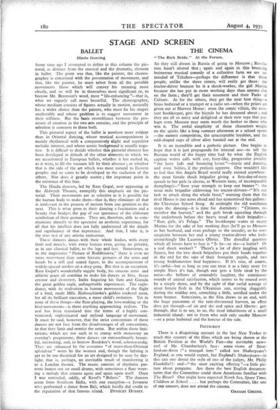STAGE AND SCREEN
BALLET
Hindu Dancing SOME time ago I attempted to define in this column the pic- torial, as distinct from the musical and the dramatic, element in ballet. The point was that, like the painter, the choreo- grapher is concerned with the presentation of movement, and that, like the painter, he must select from all the possible movements those which will convey his meaning most clearly, and so will be in themselves most significant or, to borrow Mr. Berenson's word, most " life-enhancing "—that is, what we vaguely call most beautiful. The choreographer, whose medium consists of figures actually in motion, naturally has a wider choice than the painter, who must fix his shapes unalterably and whose problem is to suggest movement in their stillness. But the basic resemblance between the pro- cesses of creation in the two arts remains, and the principle of selection is common to them both.
This pictorial aspect of the ballet is nowhere more evident than in Oriental dancing, whose musical accompaniment is mainly rhythmical with a comparatively slight and repetitive melodic interest, and whose scenic background is usually nega- tive. It is difficult to decide whether this pictorial element has been developed in default of the other elements to which we are accustomed in European ballets, whether it has rushed in, as it were, to fill the vacuum left by their absence ; or whether that is the side of the art which was most natural to Eastern peoples and so came to be developed to the exclusion of the others. Nor does it greatly matter ; the important point is the existence of this bias.
The Hindu dancers, led by Ram Gopal, now appearing at the Aldwych Theatre, exemplify this emphasis on the pic- torial. Their movements are as selective as it is possible for the human body to make them—that is, they eliminate all that is irrelevant in the process of motion from one position to the next. This is what gives to their dancing a fascination and a beauty that bridges the gap of our ignorance of the elaborate symbolism of their gestures. They are, therefore, able to com- municate directly to the spectator an aesthetic experience, for all that his intellect does not fully understand all the details and significance of that experience. And that, I take it, is the true test of any artistic endeavour.
These dancers dance .with their whole bodies, with every limb and muscle, with every feature even, giving no priority, as in our classical ballet, to the legs and feet. Sometimes, as in the impressive " Picture of Boddhisatva," there is even no more movement than some hieratic gestures of the arms and hands by a still and seated figure, to the accompaniment of widely-spaced strokes on a deep gong. But that is an exception. Ram Gopal's wonderfully supple body, his sinuous arms and athletic grace all combine to make his dances as Siva, fierce creator and destroyer, Indra fingering his flute and Garuda the great golden eagle, unforgettable experiences. The eagle- dance, with its realisation in human movements of the flight of a bird, made Mlle. Riabouchinska's golden cockerel seem, for all its brilliant execution, a mere child's imitation. Yet in none of these things—the flute-playing, the love-making or the bird-movements—is there anything approaching realism. The real has been translated into the terms of a highly con- ventional, sophisticated and stylised language of movement. It must be said, however, that the strict conventions of these dances are not free from the disadvantages of all conventions, in that they limit and restrict the artist. But within those limi- tations, which are not such as to cramp with monotony an evening's programme, these dances rre extraordinarily beauti- ful, interesting, and, to borrow Baedeker's word, sehenswurdig. They are enhanced by the costumes " of more-than-Oriental splendour " worn by the women and, though the lighting is apt to be too theatrical for an art designed to be seen by day- light, that is, perhaps, an inevitable result of transferring it to a London theatre. The music consists of rhythmic pat- terns beaten out on small drums, with sometimes a flute weav- ing a melody that returns again and again upon itself. Once I was reminded, oddly, of Ravel's " Bolero." The dancers come from Southern India, with one exception—a Javanese who performed a dance from Bali, which hardly did credit to the reputation of that famous island. DYNEI.EY HUSSEY.








































 Previous page
Previous page